Optimization of Replaced Grinding Wheel Diameter for Surface Grinding Based on a Cost Analysis
Abstract
1. Introduction
2. Methodology
- ts is the manufacturing time (h) which will be discussed in more detail following;
- Cmh is the machine tool hourly rate (USD/h) including wages, cost of maintenance etc.;
- Cg is the grinding wheel cost per workpiece (USD/workpiece). Cg can be expressed as follows:
3. Experimental Work
4. Results and Discussions
5. Conclusions
- (1)
- The initial grinding wheel diameter D0 has the largest effect on the De,op value. Meanwhile, the grinding wheel width (Wgw) and the Rockwell hardness of workpiece (HRC) do not affect the De,op value.
- (2)
- Three factors including D0, Tw, Cmh have positive influences on the De,op value. Meanwhile, the other parameters such as aed, Cgw, Wpd have negative influences on the De,op value.
- (3)
- For a certain set of technological parameters, i.e., , the De,op value is 266.86 mm. After carrying out an experiment with those values of the input parameters, the obtained result shows that the difference between the experimental De.op value and the prediction De.op value is 1.7%, indicating that the model proposed in this study is reliable.
Author Contributions
Funding
Conflicts of Interest
References
- Godino, L.; Pombo, I.; Sanchez, J.; Izquierdo, B. An Original Tribometer to Analyze the Behavior of Abrasive Grains in the Grinding Process. Metals 2018, 8, 557. [Google Scholar] [CrossRef]
- Vidal, G.; Ortega, N.; Bravo, H.; Dubar, M.; González, H. An Analysis of Electroplated cBN Grinding Wheel Wear and Conditioning during Creep Feed Grinding of Aeronautical Alloys. Metals 2018, 8, 350. [Google Scholar] [CrossRef]
- Malkin, S.; Guo, C. Grinding Technology. Theory and Applications of Machining with Abrasives; Industrial Press: New York, NY, USA, 2008. [Google Scholar]
- Peters, J.; Aerens, R. Optimization Procedure of Three Phase Grinding Cycles of a Series without Intermediate Dressing. CIRP Ann. Manuf. Technol. 1980, 29, 195–200. [Google Scholar] [CrossRef]
- Li, G.F.; Wang, L.S.; Yang, L.B. Multi-parameter optimization and control of the cylindrical grinding process. J. Mater. Process. Technol. 2002, 129, 232–236. [Google Scholar] [CrossRef]
- Gupta, R.; Shishodia, K.S.; Sekhon, G.S. Optimization of grinding process parameters using enumeration method. J. Mater. Process. Technol. 2001, 112, 63–67. [Google Scholar] [CrossRef]
- Jeongju, C. Optimal control of cylindrical plunge grinding using dynamic programming. J. Adv. Mech. Des. Syst. Manuf. 2016, 6, 581–589. [Google Scholar]
- Chekole, N.; Deshpande, V. Review analysis on optimization of cylindrical grinding process parameters by using Taguchi technique. Ind. Eng. J. 2018, 14, 35–39. [Google Scholar] [CrossRef]
- Pi, V.N.; Khiem, V.H.; Huong, N.N. Cost optimization of external cylindrical grinding. Appl. Mech. Mater. 2013, 312, 982–989. [Google Scholar] [CrossRef]
- Dasthagiri, B.; Goud, E.V. Optimization Studies on Surface Grinding Process Parameters. Int. J. Innov. Res. Sci. Eng. Technol. 2015, 4, 6148–6156. [Google Scholar]
- Patil, P.J.; Patil, C.R. Analysis of process parameters in surface grinding using single objective Taguchi and multi-objective grey relational grade. Perspect. Sci. 2016, 8, 367–369. [Google Scholar] [CrossRef]
- Saravanakumar, A.; Dhanabal, S.; Jayanand, E.; Logeshwaran, P. Analysis of Process Parameter in Surface Grinding Process. Mater. Today Proc. 2018, 5, 8131–8137. [Google Scholar] [CrossRef]
- Rana, P.; Lalwani, D.I. Parameters optimization of surface grinding process using modified ε constrained differential evolution. Mater. Today Proc. 2017, 4, 10104–10108. [Google Scholar] [CrossRef]
- Janardhan, M. An integrated evaluation approach for modeling and optimization of surface grinding process parameters. Mater. Today Proc. 2015, 2, 1622–1633. [Google Scholar] [CrossRef]
- Ngoc, P.V.; Anh, T.L.; Le Xuan, H.; Van, N.N. Experimental Determination of Optimum Exchanged Diameter in Surface Grinding Process. J. Environ. Sci. Eng. 2017, 6, 85–89. [Google Scholar]
- Hung, L.X.; Pi, V.N.; Tung, L.A.; Tu, H.X.; Jun, G.; Long, B. Determination of Optimal Exchanged Grinding Wheel Diameter when Internally Grinding Alloy Tool Steel 9CrSi. IOP Conf. Ser. Mater. Sci. Eng. 2018, 417, 012026. [Google Scholar] [CrossRef]
- Vu, N.P.; Nguyen, Q.T.; Tran, T.H.; Le, H.K.; Nguyen, A.T.; Luu, A.T.; Nguyen, V.T.; Le, X.H. Optimization of Grinding Parameters for Minimum Grinding Time When Grinding Tablet Punches by CBN Wheel on CNC Milling Machine. Appl. Sci. 2019, 9, 957. [Google Scholar] [CrossRef]
- Rowe, W.B. Principle of Modern Grinding Technology; William Andrew: Oxford, UK, 2009. [Google Scholar]
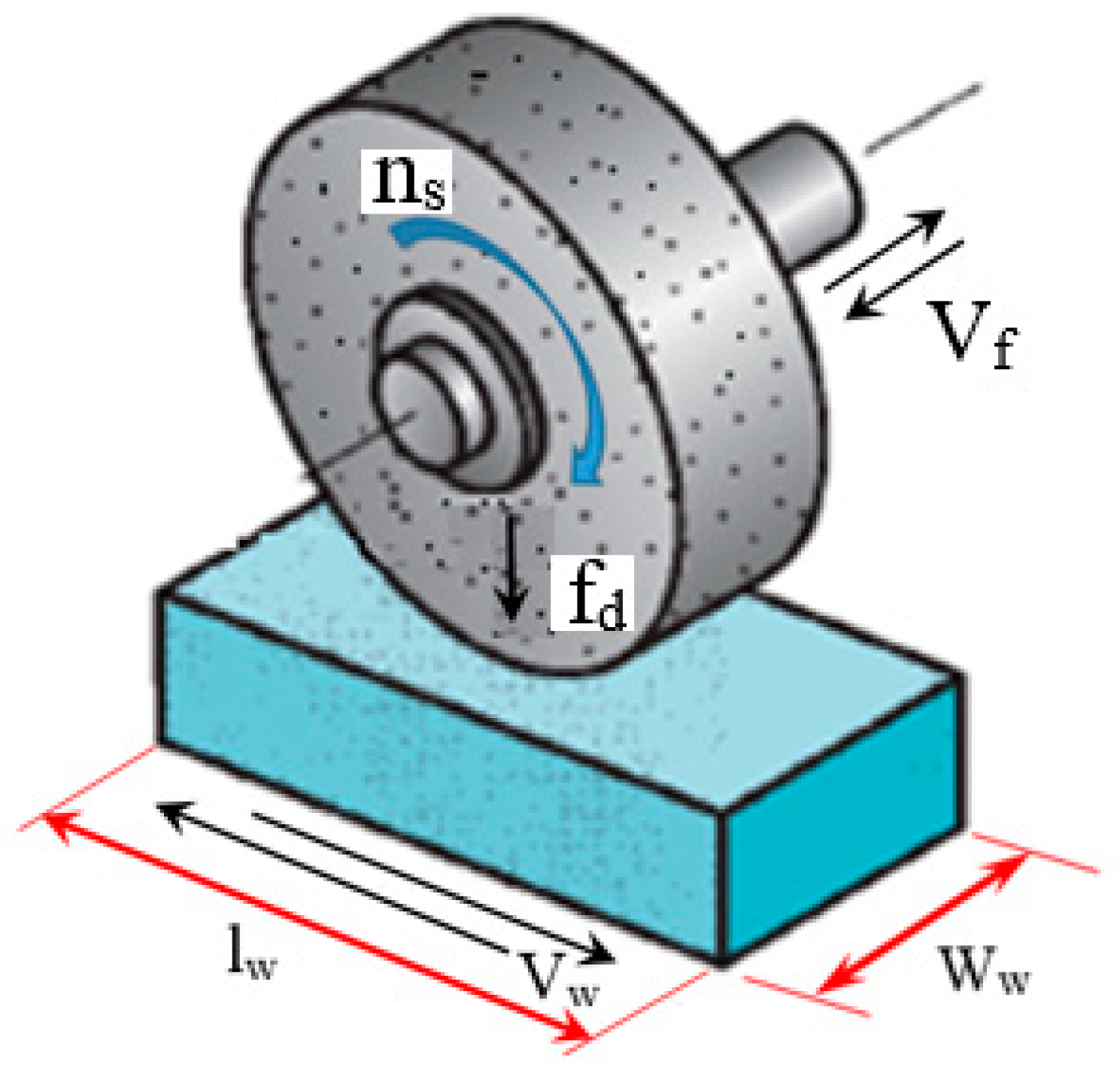
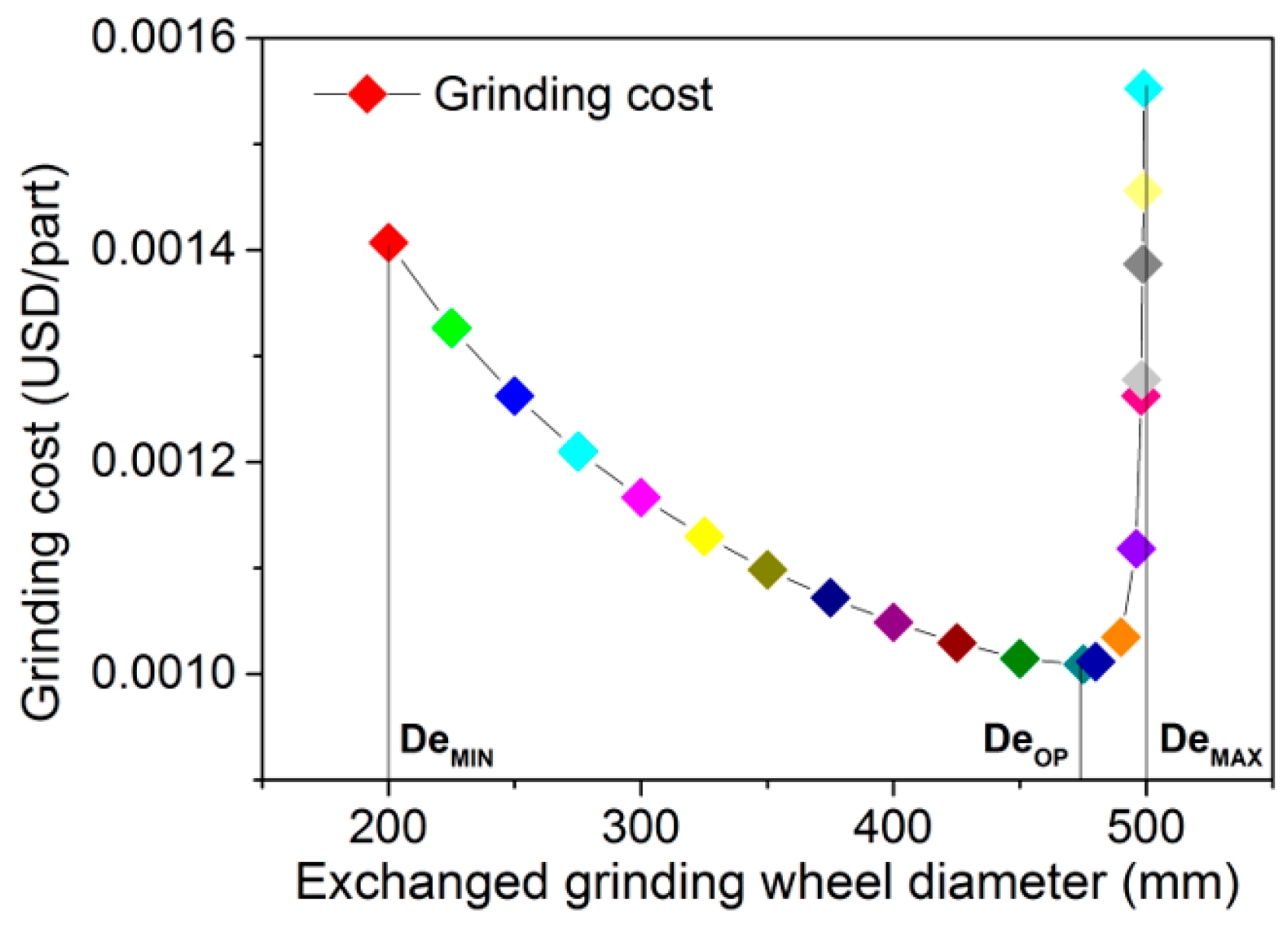


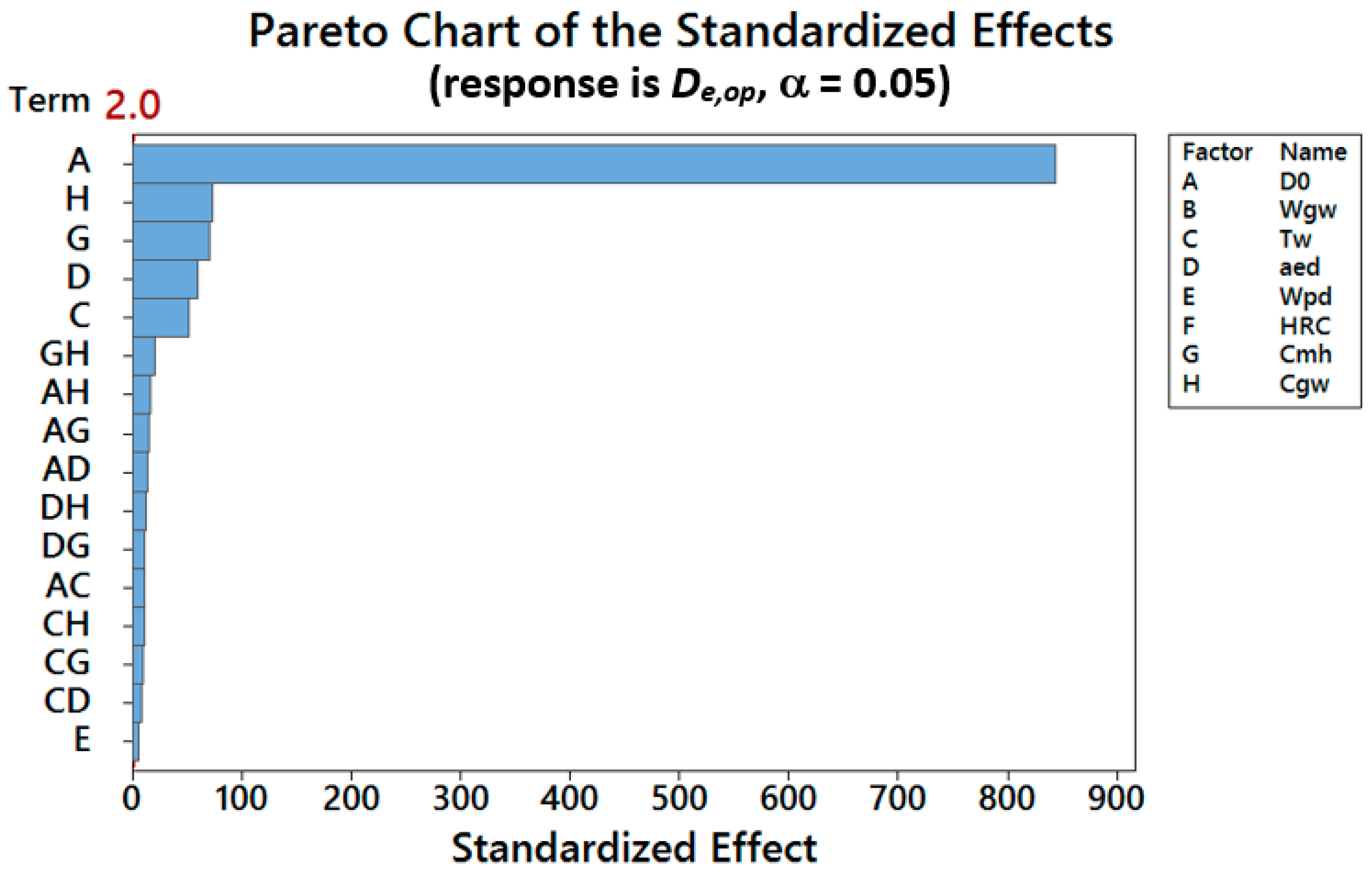
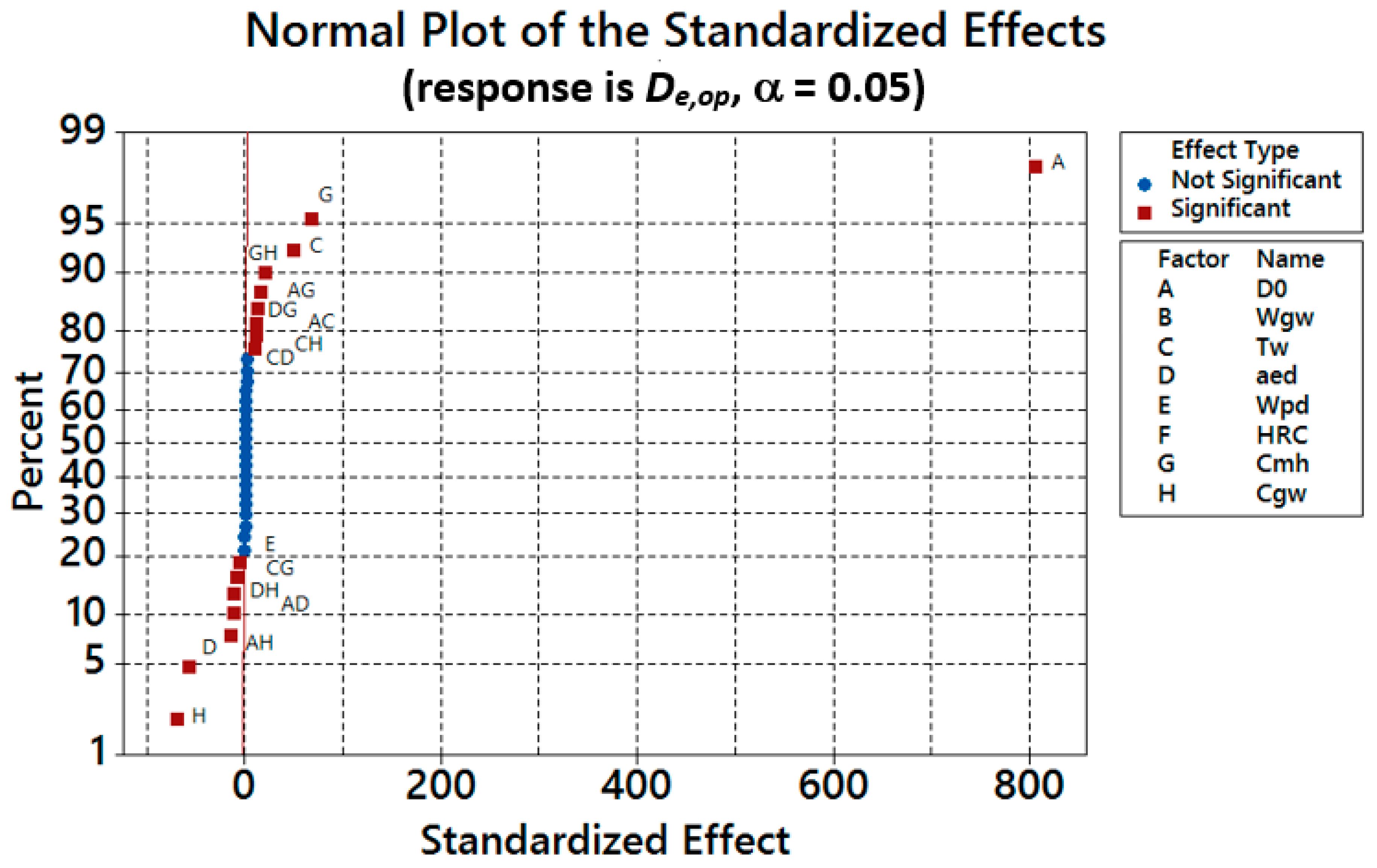
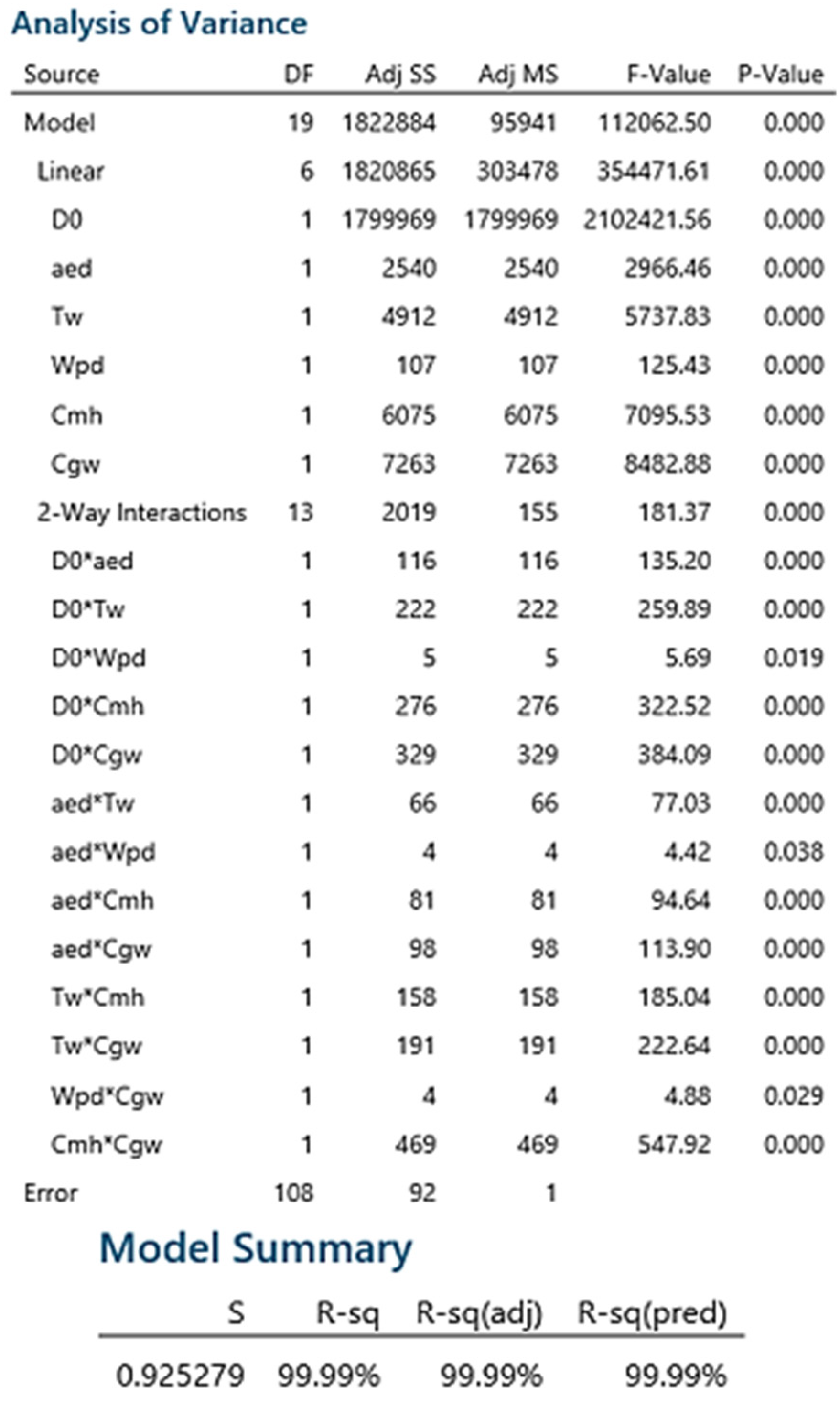
| Factor | Code | Unit | Low | High |
|---|---|---|---|---|
| Initial grinding wheel diameter | mm | 250 | 500 | |
| Grinding wheel width | Wgw | mm | 20 | 50 |
| Total depth of dressing cut | mm | 0.1 | 0.2 | |
| Rockwell hardness of workpiece | HRC | - | 20 | 65 |
| Wheel life | min | 10 | 30 | |
| Radial grinding wheel wear per dress | mm | 0.01 | 0.03 | |
| Machine tool hourly rate | USD/h | 5 | 15 | |
| Grinding wheel cost | USD/part | 15 | 50 |
| Std Order | Run Order | CenterPt | Blocks | Wgw | HRC | |||||||
|---|---|---|---|---|---|---|---|---|---|---|---|---|
| 97 | 1 | 1 | 1 | 250 | 20 | 0.1 | 20 | 10 | 0.03 | 15 | 15 | 231.75 |
| 82 | 2 | 1 | 1 | 500 | 20 | 0.1 | 20 | 30 | 0.01 | 15 | 50 | 474.52 |
| 51 | 3 | 1 | 1 | 250 | 50 | 0.1 | 20 | 30 | 0.03 | 5 | 50 | 220.16 |
| 89 | 4 | 1 | 1 | 250 | 20 | 0.1 | 65 | 30 | 0.01 | 15 | 50 | 232.38 |
| 108 | 5 | 1 | 1 | 500 | 50 | 0.1 | 65 | 10 | 0.03 | 15 | 50 | 459.16 |
| 104 | 6 | 1 | 1 | 500 | 50 | 0.2 | 20 | 10 | 0.03 | 15 | 50 | 447.25 |
| … | ||||||||||||
| 54 | 127 | 1 | 1 | 500 | 20 | 0.2 | 20 | 30 | 0.03 | 5 | 15 | 465.51 |
| 9 | 128 | 1 | 1 | 250 | 20 | 0.1 | 65 | 10 | 0.01 | 5 | 50 | 210.3 |
| Machine and Equipment | Specifications |
|---|---|
| Grinding machine | Surface grinder of Moto–Yokohama (made in Japan) |
| Grinding wheel | Cn46MV1 300 × 127 × 30 (made in Vietnam) |
| Workpiece material | 90CrSi |
| Workpiece dimensions | 100 × 60 × 30 mm3 |
| Cooling modes | Caltex Aquatex 3180 |
| Environment | Flood |
| Dresser | Multi diamond dresser, 3908-0088C type 2 (made in Russia) |
© 2019 by the authors. Licensee MDPI, Basel, Switzerland. This article is an open access article distributed under the terms and conditions of the Creative Commons Attribution (CC BY) license (http://creativecommons.org/licenses/by/4.0/).
Share and Cite
Tran, T.-H.; Luu, A.-T.; Nguyen, Q.-T.; Le, H.-K.; Nguyen, A.-T.; Hoang, T.-D.; Le, X.-H.; Banh, T.-L.; Vu, N.-P. Optimization of Replaced Grinding Wheel Diameter for Surface Grinding Based on a Cost Analysis. Metals 2019, 9, 448. https://doi.org/10.3390/met9040448
Tran T-H, Luu A-T, Nguyen Q-T, Le H-K, Nguyen A-T, Hoang T-D, Le X-H, Banh T-L, Vu N-P. Optimization of Replaced Grinding Wheel Diameter for Surface Grinding Based on a Cost Analysis. Metals. 2019; 9(4):448. https://doi.org/10.3390/met9040448
Chicago/Turabian StyleTran, Thi-Hong, Anh-Tung Luu, Quoc-Tuan Nguyen, Hong-Ky Le, Anh-Tuan Nguyen, Tien-Dung Hoang, Xuan-Hung Le, Tien-Long Banh, and Ngoc-Pi Vu. 2019. "Optimization of Replaced Grinding Wheel Diameter for Surface Grinding Based on a Cost Analysis" Metals 9, no. 4: 448. https://doi.org/10.3390/met9040448
APA StyleTran, T.-H., Luu, A.-T., Nguyen, Q.-T., Le, H.-K., Nguyen, A.-T., Hoang, T.-D., Le, X.-H., Banh, T.-L., & Vu, N.-P. (2019). Optimization of Replaced Grinding Wheel Diameter for Surface Grinding Based on a Cost Analysis. Metals, 9(4), 448. https://doi.org/10.3390/met9040448







